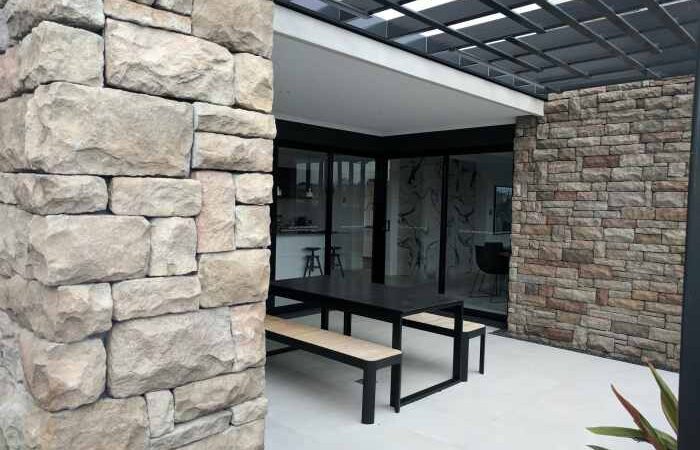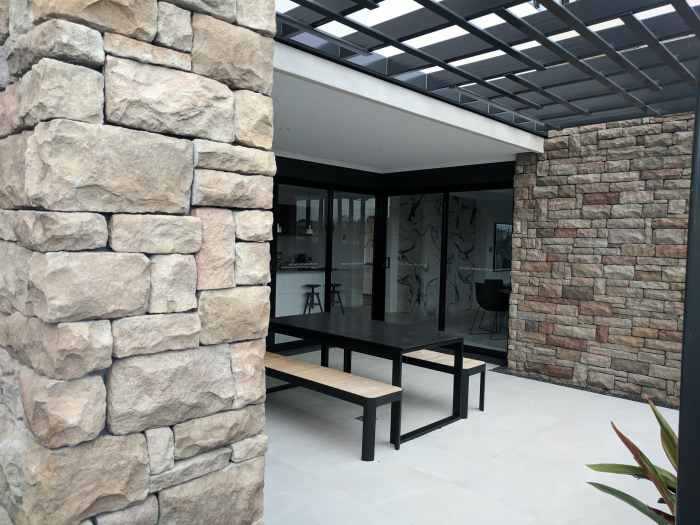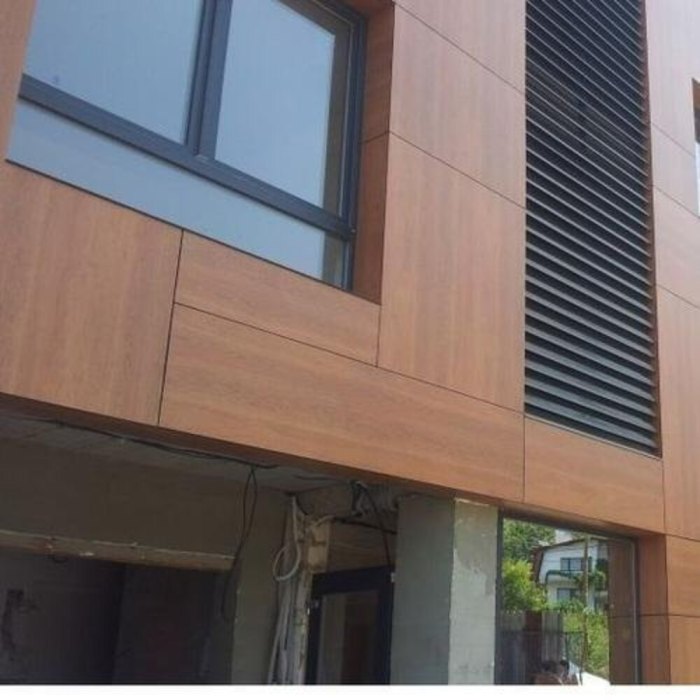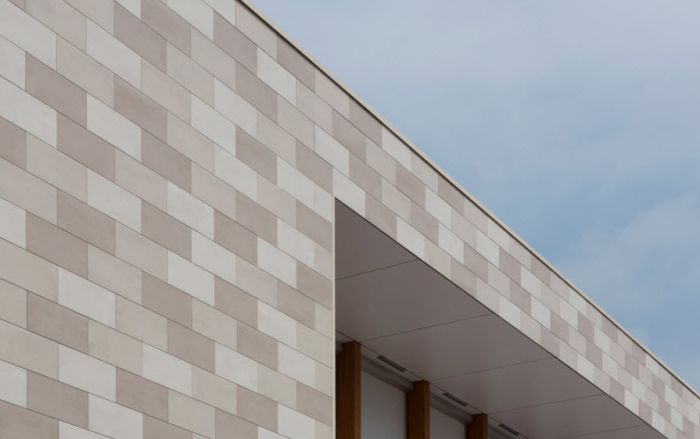Deck Siding A Complete Guide

Deck siding: Transform your outdoor space with the right material! Choosing the perfect deck siding can completely change the look and feel of your deck, boosting curb appeal and adding years of enjoyment. We’ll explore various materials—from classic cedar to modern composite—comparing durability, maintenance, cost, and aesthetic options to help you make an informed decision.
This guide covers everything from installation techniques and design ideas to maintenance tips and environmental considerations. Whether you’re a seasoned DIYer or a first-time deck builder, we’ll equip you with the knowledge to create a stunning and long-lasting deck.
Types of Deck Siding Materials
Choosing the right siding for your deck is a crucial decision impacting both aesthetics and longevity. This section will explore popular deck siding materials, comparing their durability, maintenance needs, and costs to help you make an informed choice. We’ll cover cedar, composite, vinyl, and metal, highlighting their respective strengths and weaknesses.
Cedar Deck Siding Durability, Maintenance, and Cost
Cedar is a classic choice known for its natural beauty and rich aroma. However, its durability is moderate compared to other options. It’s susceptible to rot, insect infestation, and weathering, requiring regular maintenance like sealing and occasional sanding. Expect to reseal every 2-3 years to protect it from the elements. Cedar’s initial cost is relatively moderate, but the ongoing maintenance can add up over time. Installation costs are generally in line with other natural wood options.
Composite Deck Siding Durability, Maintenance, and Cost
Composite decking, often made from a blend of recycled plastic and wood fibers, offers excellent durability. It resists rot, insects, and weathering far better than cedar. Maintenance is minimal, usually involving occasional cleaning with soap and water. Composite siding is significantly more expensive than cedar upfront, but its low maintenance offsets some of the initial cost over the long run. Installation costs are generally higher than cedar due to the material’s weight and sometimes a more complex installation process.
Vinyl Deck Siding Durability, Maintenance, and Cost
Vinyl siding provides exceptional durability and requires virtually no maintenance beyond occasional cleaning. It’s highly resistant to rot, insects, and weathering, making it a low-maintenance option. Vinyl is typically less expensive than composite initially, but its appearance may be considered less natural by some. Installation costs are usually moderate, falling somewhere between cedar and composite.
Metal Deck Siding Durability, Maintenance, and Cost
Metal deck siding, often aluminum or steel, boasts exceptional durability and longevity. It’s extremely resistant to rot, insects, and weathering, requiring minimal maintenance. Regular cleaning will keep it looking its best. While metal siding is generally more expensive than vinyl and cedar upfront, its extremely long lifespan and low maintenance make it a cost-effective choice in the long term. Installation costs can vary depending on the chosen material and complexity of the project.
Deck Siding Material Comparison
| Material | Durability | Maintenance | Cost (Approximate Range) |
|---|---|---|---|
| Cedar | Moderate; susceptible to rot and insects | High; regular sealing and occasional sanding required | $5-$15 per square foot (including installation) |
| Composite | High; resists rot, insects, and weathering | Low; occasional cleaning | $15-$30 per square foot (including installation) |
| Vinyl | High; resists rot, insects, and weathering | Very low; occasional cleaning | $8-$20 per square foot (including installation) |
| Metal | Very high; extremely durable and long-lasting | Very low; occasional cleaning | $15-$35 per square foot (including installation) |
Deck Siding Installation Techniques
Installing deck siding can significantly enhance your outdoor space’s aesthetic appeal and durability. The process varies depending on the material you choose, each requiring specific techniques and tools for optimal results. This section Articulates the key steps for installing common deck siding materials.
Cedar Deck Siding Installation
Cedar siding offers a natural, elegant look. Successful installation involves careful planning and precise execution. Begin by preparing the deck surface, ensuring it’s clean, level, and free from any debris. Measure and cut the cedar planks to the required lengths, allowing for slight overlaps. Apply a weather-resistant sealant to the back of each plank before installation to protect against moisture damage. Start at the bottom of the deck and work your way up, using galvanized nails or screws to secure the planks, ensuring they’re evenly spaced and aligned. Remember to leave expansion gaps to account for seasonal changes in wood. Finally, apply a protective finish, such as a stain or sealant, to enhance the cedar’s natural beauty and prolong its lifespan.
Composite Deck Siding Installation
Composite siding offers low maintenance and durability. Proper fastening is crucial for a long-lasting installation. Before beginning, prepare the deck surface as you would for cedar siding. Composite siding often comes with pre-drilled holes, simplifying installation. Use the recommended fasteners provided by the manufacturer; typically, these are stainless steel screws designed to prevent corrosion. Fasten the siding securely, avoiding over-tightening, which could cause cracking. Maintain consistent spacing between the planks and ensure they are properly aligned. Composite siding usually requires less maintenance than natural wood, but periodic cleaning can prevent dirt and debris buildup.
Vinyl Deck Siding Installation
Vinyl siding is known for its ease of installation and low maintenance. Achieving a clean finish requires attention to detail. Prepare the deck surface by cleaning and ensuring it is level. Vinyl siding typically interlocks, simplifying installation. Start at one corner and work your way across the deck, ensuring each panel snaps securely into place. Use appropriate J-channel and finishing pieces to create a neat and professional look at the corners and edges. Use the appropriate fasteners or clips recommended by the manufacturer for a secure and clean finish. Avoid forcing panels into place, as this could cause damage. Proper installation of vinyl siding ensures a clean, professional look that will withstand the elements for many years.
Metal Deck Siding Installation
Metal deck siding, often made of aluminum or steel, provides exceptional durability and weather resistance. This installation requires specific tools and safety precautions. Begin by preparing the deck surface as with other siding types. Measure and cut the metal panels to the required dimensions using metal-cutting shears or a saw with a metal-cutting blade. Wear appropriate safety gear, including gloves and eye protection, when handling metal siding. Use self-tapping screws or rivets to fasten the panels, ensuring they are securely attached and aligned. Overlapping panels should be properly sealed to prevent water penetration. Remember to follow the manufacturer’s instructions for installation and fastening to ensure a long-lasting, weather-tight installation.
Deck Siding Design and Aesthetics
Choosing the right deck siding isn’t just about protection; it’s about enhancing the overall look and feel of your outdoor space. The design you select significantly impacts the aesthetic appeal of your deck, complementing your home and creating a welcoming atmosphere. Consider both contemporary and traditional styles to find the perfect match for your taste and existing architecture.
The design options for deck siding are surprisingly diverse. Beyond the material itself, color, pattern, and overall style significantly impact the final aesthetic. Understanding these elements allows for a truly personalized deck design.
Color Choices and Patterns
Color selection plays a crucial role in setting the mood and style of your deck. Natural wood tones, like cedar’s warm browns and reds, offer a classic and timeless look. However, modern trends also embrace bolder colors, including grays, blues, and even greens, depending on the surrounding landscape and the overall home style. Patterns, while less common than solid colors, can add a unique touch. For example, a horizontal siding pattern creates a sense of spaciousness, while vertical siding can add height and visual interest. A combination of colors or a subtle two-tone effect can also be used to add depth and sophistication.
Popular Design Trends in Deck Siding
Contemporary deck designs often feature clean lines and minimalist aesthetics. Siding choices lean towards sleek, low-maintenance materials like composite decking, often in neutral colors like gray or charcoal. Traditional styles, conversely, tend to embrace the warmth and natural beauty of wood, with cedar or redwood being popular choices. These designs might incorporate more intricate patterns or details, such as decorative trim or contrasting accents. The current trend leans towards a blend of these styles; for example, using a modern composite material in a traditional horizontal pattern.
Design Considerations for Integrating Deck Siding with Existing Home Architecture
Before choosing your deck siding, carefully consider your home’s architectural style. A modern home with clean lines and a minimalist aesthetic might look incongruous with a deck featuring rustic wood siding. Conversely, a Victorian-style home would likely benefit from a deck that incorporates more ornate detailing and traditional materials. Matching or complementing the existing home’s exterior colors and materials is also essential for a cohesive and visually appealing result. Think about the overall color palette of your house – are the dominant colors warm or cool? Choose siding that harmonizes with these tones. For example, a house with a brick facade might pair well with a deck featuring cedar siding in a warm brown tone.
Visual Description of a Cedar Deck
Imagine a deck clad in rich, reddish-brown cedar siding. The horizontal planks, evenly spaced and meticulously installed, showcase the natural texture of the wood; you can almost feel the subtle grain beneath your fingertips. The color varies slightly from plank to plank, revealing the natural variations in the wood’s tone, creating a warm, inviting ambiance. The overall aesthetic is one of rustic elegance, blending seamlessly with the surrounding natural environment. The sun’s rays catch the surface of the wood, highlighting its natural beauty and creating a play of light and shadow that shifts throughout the day.
Deck Siding Maintenance and Repair

Source: com.au
Keeping your deck siding looking its best and extending its lifespan requires a proactive maintenance plan. Regular cleaning and occasional repairs will prevent minor issues from becoming major headaches down the line. The type of siding you choose will influence the specifics of your maintenance routine, but the general principles remain the same.
Maintenance Schedules for Different Deck Siding Materials
Different deck siding materials require varying levels of maintenance. A regular schedule tailored to your specific material is crucial for longevity.
- Wood: Wood siding needs annual cleaning with a mild detergent and water solution, followed by a protective sealant every 2-3 years. More frequent sealing might be necessary in harsh climates. Regular inspection for rot, insect damage, and loose boards is also important.
- Composite: Composite siding generally requires less maintenance than wood. Annual cleaning with soap and water is usually sufficient. Inspect for any signs of damage or fading. While generally more resistant to rot and insects, some composites may require occasional cleaning with a specialized composite cleaner.
- Vinyl: Vinyl siding is known for its low-maintenance nature. Regular cleaning with soap and water is typically all that’s needed. Occasional rinsing with a garden hose can remove dirt and debris. Inspect for cracks or damage.
- Metal: Metal siding is extremely durable and requires minimal maintenance. Regular cleaning with soap and water will remove dirt and grime. Inspect for rust or dents, and address them promptly.
Cleaning and Protecting Deck Siding
Effective cleaning and protection are key to maintaining your deck siding’s appearance and structural integrity.
Cleaning methods vary depending on the material. For wood, a soft-bristled brush and a mild detergent solution are recommended. For composite and vinyl, a simple soap and water solution is often sufficient. Power washing can be used but should be done carefully to avoid damaging the siding. Always test any cleaning solution on a small, inconspicuous area first.
Protecting your deck siding involves applying a sealant or protective coating. Wood siding benefits from regular sealing to prevent water damage and insect infestation. Sealants are available in various finishes to match your aesthetic preferences. Composite and vinyl siding usually don’t require sealing, but a protective coating can enhance their color and UV resistance.
Common Deck Siding Problems and Solutions
Several issues can affect deck siding over time. Early identification and prompt action are crucial to prevent extensive damage.
- Rot and Decay (Wood): Caused by moisture exposure. Solution: Repair or replace affected boards. Preventative measures include proper sealing and ventilation.
- Insect Infestation (Wood): Termites and other insects can damage wood siding. Solution: Treat with insecticide and repair or replace damaged sections. Preventative measures include regular inspection and sealing.
- Fading (All Materials): Sun exposure can cause fading. Solution: Apply a protective coating or sealant with UV protection.
- Cracks and Splits (Wood, Composite, Vinyl): This can occur due to temperature fluctuations or impact damage. Solution: Repair or replace damaged sections. Preventative measures include regular inspection and careful handling.
- Rust (Metal): Rust can develop on metal siding due to exposure to moisture. Solution: Clean and treat with a rust remover and protective paint.
Repair Techniques for Damaged Deck Siding
Repairing damaged deck siding often involves replacing individual boards or sections.
For wood siding, damaged boards can be carefully removed using a pry bar and replaced with new boards of the same size and type. Ensure proper fastening to prevent future movement. For composite and vinyl siding, damaged sections may need to be cut out and replaced with new pieces, ensuring a tight and weatherproof seal. Metal siding repairs may involve patching dents or replacing rusted sections. Always follow the manufacturer’s instructions for specific repair techniques for your chosen material. Remember to use appropriate fasteners and sealants to ensure a durable and watertight repair.
Deck Siding and Environmental Impact
Choosing deck siding involves more than just aesthetics and durability; it significantly impacts the environment. The manufacturing process, material sourcing, and eventual disposal all contribute to a material’s overall environmental footprint. Understanding these factors helps make informed decisions that minimize your deck’s environmental impact.
The environmental impact of deck siding materials varies considerably. Factors such as energy consumption during manufacturing, transportation distances, and the material’s biodegradability all play a role. Some materials require more energy-intensive processes than others, resulting in higher carbon emissions. Similarly, the transportation of materials from distant sources adds to the environmental burden. Finally, the disposal method, whether landfill or recycling, influences the long-term environmental effects.
Manufacturing Processes and Disposal of Different Deck Siding Materials
Different deck siding materials have vastly different environmental impacts stemming from their manufacturing processes and disposal methods. Pressure-treated lumber, for example, often involves the use of chemical preservatives which can have negative consequences for soil and water quality if not handled responsibly. While generally durable, its disposal can be challenging due to the presence of these chemicals. Composite materials, while often touted as environmentally friendly, require significant energy input during manufacturing and may contain plastics that are not easily biodegradable. On the other hand, naturally durable hardwoods like cedar or redwood, while requiring harvesting, have a lower manufacturing impact and are often more easily biodegradable than other options. Metal siding, such as aluminum or steel, requires substantial energy during manufacturing, but it is highly recyclable and durable.
Sustainability of Reclaimed or Recycled Materials
Using reclaimed or recycled materials for deck siding offers a significant environmental advantage. Reclaimed wood, for instance, avoids the need for new timber harvesting, reducing deforestation and its associated impacts on biodiversity and carbon sequestration. Recycled plastic lumber provides an alternative to virgin plastic production, decreasing reliance on fossil fuels and reducing plastic waste in landfills. The embodied energy – the total energy used to create a material – is significantly lower for reclaimed and recycled materials compared to their virgin counterparts. For example, using reclaimed barn wood for a deck not only provides a unique aesthetic but also diverts waste from landfills and reduces the demand for newly harvested lumber.
Environmentally Friendly Deck Siding Options
Several deck siding options minimize the carbon footprint. Bamboo, a rapidly renewable resource, offers a strong and attractive alternative to traditional lumber. Its rapid growth rate allows for sustainable harvesting, and its inherent strength and durability contribute to a long lifespan. Recycled plastic lumber, made from recycled plastics, reduces plastic waste and minimizes the demand for virgin materials. While its manufacturing process still requires energy, it significantly reduces the overall environmental impact compared to traditional lumber. Furthermore, sustainably harvested hardwoods, certified by organizations like the Forest Stewardship Council (FSC), ensure that the wood comes from responsibly managed forests, minimizing environmental damage.
Benefits of Low-VOC Paints and Stains
Using low-VOC (volatile organic compound) paints and stains on deck siding offers significant environmental benefits. VOCs are released into the atmosphere during the application and curing of paints and stains, contributing to air pollution and smog formation. Low-VOC or zero-VOC options minimize these emissions, protecting air quality and reducing health risks. These paints and stains are also often made with more sustainable ingredients, further reducing their environmental impact. Choosing these products helps create a healthier environment both during application and throughout the life of the deck.
Deck Siding Cost and Budgeting

Source: imimg.com
Planning a deck siding project requires careful consideration of the costs involved. Understanding the various expense categories and potential savings strategies can help you create a realistic budget and avoid unexpected financial surprises. This section breaks down the typical costs associated with deck siding, providing examples and tips for smart budgeting.
Budget Breakdown for a Typical Deck Siding Project
A typical deck siding project budget encompasses several key areas: materials, labor, and permits. The specific costs will vary greatly depending on factors such as deck size, chosen materials, location, and the complexity of the installation. Let’s look at a sample breakdown for a medium-sized deck (approximately 200 square feet):
| Cost Category | Estimated Cost | Notes |
|---|---|---|
| Materials (Siding, Fasteners, Trim) | $1,500 – $4,000 | Prices vary significantly based on material choice (e.g., composite, vinyl, wood). Higher-end materials will increase this cost. |
| Labor | $1,000 – $3,000 | Labor costs depend on the contractor’s rates and the complexity of the installation. More intricate designs or difficult access will increase labor costs. |
| Permits | $100 – $500 | Permit costs vary by location and the scope of the project. Check with your local building department for specific requirements and fees. |
| Total Estimated Cost | $2,600 – $7,500 | This is a broad range. Actual costs may be higher or lower depending on the specifics of your project. |
Pricing Structures for Deck Siding Installation Services
Contractors typically offer different pricing structures for deck siding installation. Some common approaches include:
- Per square foot: This is a common method where the contractor charges a set price per square foot of siding installed. This can range from $5 to $20 or more per square foot, depending on the material and complexity.
- Hourly rate: Some contractors charge an hourly rate for their labor, plus the cost of materials. This method is often used for smaller or more complex projects.
- Fixed price contract: A fixed price contract Artikels the total cost of the project upfront, including materials and labor. This provides clarity and helps avoid unexpected costs.
It’s crucial to obtain multiple quotes from different contractors to compare pricing and services before making a decision.
Tips for Saving Money on Deck Siding Installation
Several strategies can help you reduce costs without sacrificing quality:
- Choose less expensive materials: While premium materials offer durability and aesthetics, more budget-friendly options like vinyl or treated wood can significantly lower the overall cost.
- DIY installation (if feasible): If you have the skills and time, installing the siding yourself can save a substantial amount on labor costs. However, carefully assess your capabilities before attempting this.
- Shop around for materials: Compare prices from different lumber yards and home improvement stores to find the best deals on siding and other necessary materials.
- Consider the timing: Contractors’ rates might fluctuate seasonally. Inquiring during the off-season may yield better pricing.
Factors Affecting the Overall Cost of a Deck Siding Project
Several factors significantly influence the total cost of a deck siding project:
- Deck size and complexity: Larger decks and those with intricate designs will require more materials and labor, increasing the overall cost.
- Material choice: The type of siding chosen (e.g., composite, vinyl, wood) directly impacts the cost. Composite and high-end wood siding are generally more expensive than vinyl or treated lumber.
- Labor rates: Contractor rates vary by location and experience. Experienced and highly rated contractors may charge more than those with less experience.
- Permitting fees: Permitting costs vary depending on local regulations and the scope of the project.
- Accessibility: Difficult-to-access decks may increase labor costs due to the additional time and effort required.
Conclusion

Source: windows.net
Ultimately, selecting the best deck siding depends on your budget, desired aesthetic, and maintenance preferences. By carefully weighing the pros and cons of each material and considering your individual needs, you can confidently choose a siding option that will enhance your outdoor living space for years to come. Remember to factor in installation costs and long-term maintenance when making your final decision. Happy decking!
FAQ Guide
What’s the lifespan of different deck siding materials?
Lifespans vary greatly. Cedar can last 15-20 years with proper maintenance, composite 20-30 years, vinyl 20-30+ years, and metal even longer, potentially 50+ years.
Can I install deck siding myself?
While possible for some materials (like vinyl), professional installation is often recommended, especially for complex designs or materials like cedar or composite, to ensure proper fastening and longevity.
How often should I clean my deck siding?
Frequency depends on the material and climate. Generally, a yearly cleaning with soap and water is a good starting point. More frequent cleaning might be needed in areas with heavy pollen or mildew.
What are some common deck siding problems?
Common issues include warping, cracking (especially with wood), fading, and insect damage. Proper maintenance and material selection can help mitigate these problems.
Are there eco-friendly deck siding options?
Yes! Consider recycled composite materials, sustainably harvested cedar or bamboo. Using low-VOC paints and stains also reduces environmental impact.
Comments are closed.